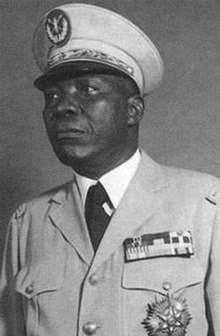Sangoulé Lamizana
Aboubakar Sangoulé Lamizana (January 31, 1916 – May 26, 2005) was a Burkinabé military officer who served as the President of Upper Volta (since 1984 renamed Burkina Faso), in power from January 3, 1966, to November 25, 1980. He held the additional position of Prime Minister from February 8, 1974, to July 7, 1978.
Sangoulé Lamizana | |
|---|---|
 | |
| 2nd President of Upper Volta | |
| In office January 3, 1966 – November 25, 1980 | |
| Preceded by | Maurice Yaméogo |
| Succeeded by | Saye Zerbo |
| 2nd Prime Minister of Upper Volta | |
| In office February 8, 1974 – July 7, 1978 | |
| Preceded by | Gérard Kango Ouédraogo |
| Succeeded by | Joseph Conombo |
| Personal details | |
| Born | January 31, 1916 Dianra |
| Died | May 26, 2005 (aged 89) Ouagadougou |
Biography
After Upper Volta achieved complete independence from the French Union in 1960, opposition parties either merged with the governing party, Union démocratique voltaïque (UDV), or were banned, transforming Upper Volta into a single party state, headed by Maurice Yaméogo as President. Yaméogo's one-party regime elicited much unrest; student strikes and mass demonstrations by students, labor unions, and civil servants. Yaméogo was forced to resign after a general strike on January 3, 1966, giving power to General Sangoulé Lamizana on the demonstrators' demand.
Lamizana served as nominal head of a "provisional military government" until a new Constitution, ratified on June 14, 1970, provided for a four-year transition to fully civilian elected leadership; he was also foreign minister from 1966 to 1967. Elections under the new Constitution delivered a clear majority of the assembly to the UDV.
In the early 1970s the effect of a five-year drought and increasing desertification in the Sahel brought the threat of famine to several nations including Upper Volta. The resulting economic dislocation encouraged factionalism in the government, headed by Gérard Ouédraogo, the prime minister who had been appointed by Lamizana. Again military intervention and dissolution of the assembly brought Lamizana back in control, essentially now as dictator.
Lamizana's regime had international recognition and visited with U.S. President Richard Nixon.[1] On 15 October, 1973 Lamizana met with President Nixon and briefed him on the Sahel drought in the Oval Office.[2] Lamizana explained that he represented himself and the other Sahel governments and hoped to secure aid during the famine and drought. Nixon promised to provide as much help as he could.
His personal party following was styled the National Movement for Renewal, although that became a short-lived formation. A new Constitution was written and approved in 1977, and Lamizana was reelected in open elections in 1978: this election is generally considered as being among the most democratic ever held in West Africa. Later Lamizana joined UDV.
With the support of unions and civil groups, Col. Saye Zerbo overthrew Lamizana in a bloodless military coup in November 1980.
See also
References
- "Burkina Faso - Visits by Foreign Leaders - Department History - Office of the Historian". history.state.gov. Retrieved 26 April 2018.
- File:Nixon, Upper Volta President Lamizana - October 15, 1973(Gerald Ford Library)(1552621).pdf
External links
| Political offices | ||
|---|---|---|
| Preceded by Maurice Yaméogo |
President of Upper Volta 1966–1980 |
Succeeded by Saye Zerbo |